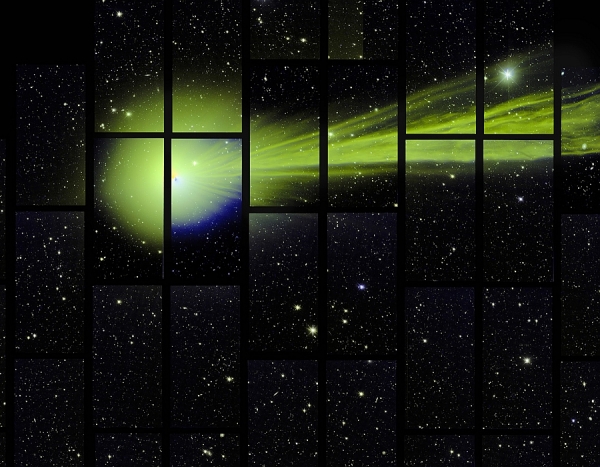Best Image of Comet Lovejoy Captured by World's Most Powerful Digital Camera
| Ana Verayo | | Mar 01, 2015 11:31 AM EST |
(Photo : Fermilab / Marty Murphy / Nikolay Kuropatkin / Huan Lin / Brian Yanny) Accidental photo of Comet Lovejoy is the best image yet of the comet.
A 570 megapixel camera designed to track dark energy accidentally captured comet Lovejoy and the composite photo appeared to be the best photo yet of the comet.
This special camera found at the Cerro Tololo Inter-American Observatory in Chile uses a targeting system to record images spanning large fields. This camera is the most powerful digital camera on Earth to date.
Like Us on Facebook
This photograph was taken December 27, 2014 when the comet, or comet C/2011 W3, was passing through the southern skies. When the comet was photographed, the icy object was about 51 million miles away from Earth.
The Dark Energy Camera is capable of recording images of objects from as far as eight billion light years away from our planet. At times, it also records objects close to Earth such as comets and asteroids.
Comet Lovejoy takes up a very small part of the sky and there were no plans on following the comet. The camera, however, was scanning that part of the sky at that time.
Comet Lovejoy possesses an icy nucleus about three miles in diameter and is shrouded by dust and gas covering 400,000 miles from side to side.
Comets are often considered "dirty snowballs" since they usually consist of dry ice, frozen water, small rocks and dust and chemicals such as ammonia. When they approach their host star during their orbits, the increasing heat causes intense activity in the icy body and forms those distinct comet tails.
Comet Lovejoy was first spotted by amateur astronomer Terry Lovejoy in August 2014. What makes this comet unique is the distinct glowing green color from cyanogen and diatomic atom from carbon atoms that become fluorescent from ultraviolet light by the sun.
It also has a distinct blue glow caused by carbon monoxide emanating from its tail.
TagsBest Image of Comet Lovejoy Captured by World's Most Powerful Digital Camera, Comet Lovejoy, world's most powerful digital camera, dark energy camera, comets, dark energy, photo image comet lovejoy
©2015 Chinatopix All rights reserved. Do not reproduce without permission
EDITOR'S PICKS
-

Did the Trump administration just announce plans for a trade war with ‘hostile’ China and Russia?
-

US Senate passes Taiwan travel bill slammed by China
-

As Yan Sihong’s family grieves, here are other Chinese students who went missing abroad. Some have never been found
-

Beijing blasts Western critics who ‘smear China’ with the term sharp power
-

China Envoy Seeks to Defuse Tensions With U.S. as a Trade War Brews
-

Singapore's Deputy PM Provides Bitcoin Vote of Confidence Amid China's Blanket Bans
-

China warns investors over risks in overseas virtual currency trading
-

Chinese government most trustworthy: survey
-

Kashima Antlers On Course For Back-To-Back Titles
MOST POPULAR
LATEST NEWS
Zhou Yongkang: China's Former Security Chief Sentenced to Life in Prison

China's former Chief of the Ministry of Public Security, Zhou Yongkang, has been given a life sentence after he was found guilty of abusing his office, bribery and deliberately ... Full Article
TRENDING STORY

China Pork Prices Expected to Stabilize As The Supplies Recover

Elephone P9000 Smartphone is now on Sale on Amazon India

There's a Big Chance Cliffhangers Won't Still Be Resolved When Grey's Anatomy Season 13 Returns

Supreme Court Ruled on Samsung vs Apple Dispute for Patent Infringement

Microsoft Surface Pro 5 Rumors and Release Date: What is the Latest?










